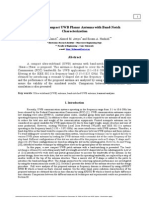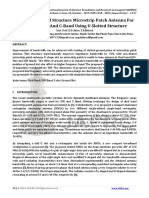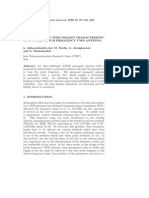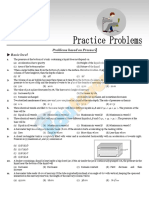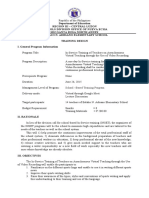Frequency Reconfigurable U-Slot Microstrip Patch Antenna
Frequency Reconfigurable U-Slot Microstrip Patch Antenna
Uploaded by
GAUTI2212Copyright:
Available Formats
Frequency Reconfigurable U-Slot Microstrip Patch Antenna
Frequency Reconfigurable U-Slot Microstrip Patch Antenna
Uploaded by
GAUTI2212Original Description:
Original Title
Copyright
Available Formats
Share this document
Did you find this document useful?
Is this content inappropriate?
Copyright:
Available Formats
Frequency Reconfigurable U-Slot Microstrip Patch Antenna
Frequency Reconfigurable U-Slot Microstrip Patch Antenna
Uploaded by
GAUTI2212Copyright:
Available Formats
IEEE ANTENNAS AND WIRELESS PROPAGATION LETTERS, VOL.
7, 2008
127
Frequency Recongurable U-Slot Microstrip Patch Antenna
Shing-Lung Steven Yang, Member, IEEE, Ahmed A. Kishk, Fellow, IEEE, and Kai-Fong Lee, Fellow, IEEE
AbstractA frequency recongurable microstrip patch antenna is presented. It is found that the incorporation of a U-slot in the patch can provide a at input resistance and a linear input reactance across a wider bandwidth than the conventional patch antenna. By placing a variable capacitor and an inductor at the antenna input, the impedance matching frequency of the antenna can be varied. The fabricated prototype antenna attains a tunable frequency range from 2.6 to 3.35 GHz. The proposed antenna is simple in structure, and the control circuitry is placed underneath the ground plane. It is suitable for use in reducing the crosstalk from adjacent channels in multichannel system. Index TermsFrequency tunable, microstrip patch antenna, recongurable antenna.
I. INTRODUCTION
ICROSTRIP patch antennas are widely employed in wireless communication systems. However, conventional microstrip patch antennas have the disadvantage of narrow bandwidth, which would not be suitable for modern mobile communication systems. The addition of a U-shaped slot on a microstrip patch [1], [2] is one of the techniques proposed to enhance the impedance matching bandwidth of probe feed microstrip patch antenna with thick substrate. It is pointed out in [2] that the U-slot could introduce a capacitive component to counteract the large input inductance when thick substrate is used. One of the techniques proposed to change the resonant frequency of a microstrip antenna is presented in [3] and [4]. An air gap is introduced between the substrate and the ground plane, which could lower the effective permittivity of the cavity under the patch. Hence, the resonant frequency of the antenna could be tuned by adjusting the thickness of the air gap. However, this method requires adjusting the air gap width mechanically, which is not an easy task in practice. Recongurable antennas have found increasing attention in recent years. Antenna performance reconguration is usually achieved by incorporating switches, variable capacitors, varactor diodes or MEMS switches in the design of the antenna. These enable the frequency response, radiation patterns, gain or the combination of various antenna parameters to be controlled. In [5], a dual-band antenna is designed by inserting a chip capacitor across the slots, and the impedance matching frequency could be changed when different capacitor values are used. In
Fig. 1. Geometry of the proposed antenna.
[6], a dual-band slot antenna is presented. Changing the bias applied across a varactor diode, which introduces a variation in capacitance, could vary the matching frequency. However, these papers incorporated the components on the radiating element, which may introduce difculties in antenna fabrication. In this letter, a frequency tunable U-slot microstrip patch antenna is presented. Variable chip capacitor (trimmer) is used to control the frequency of the antenna. The geometry and results of the proposed antenna will be separately presented in the following sections, and a brief discussion about the function of the U-slot will be presented. Finally, a conclusion remark will be drawn. II. ANTENNA GEOMETRY The geometry of the proposed U-slot frequency tunable antenna is shown in Fig. 1. The patch has a dimension (W L) of 77 mm 57 mm, and is placed 12 mm (H) above the ground is used to plane. In the fabricated prototype, foam is used in the simsupport the patch; while free space ulation. The U-slot has a width (U ) and length (U ) of 32 mm and 31 mm respectively; a gap width (U ) of 2 mm, and it is 14.5 mm away from the upper edge of the patch (U ). Probe is
Manuscript received November 30, 2007; revised January 14, 2008. The authors are with the Department of Electrical Engineering, University of Mississippi, University, MS 38677 USA (e-mail: slsteven@olemiss.edu). Color versions of one or more of the gures in this letter are available online at http://ieeexplore.ieee.org. Digital Object Identier 10.1109/LAWP.2008.921330
1536-1225/$25.00 2008 IEEE
128
IEEE ANTENNAS AND WIRELESS PROPAGATION LETTERS, VOL. 7, 2008
Fig. 3. Measured return loss of the proposed antenna when different capacitance value is obtained by rotating the trimmer.
Fig. 2. Schematic and geometry of the tuning circuitry (back side of the antenna).
used to excite the U-slot patch antenna, and the probe location is 26 mm away from the lower edge of the patch (d). The ground L ) 150 mm 150 mm. Microstrip plane dimension is (W transmission line is fabricated underneath the ground plane for the xture of the tuning components. The substrate has a dielectric constant of 2.6 and a thickness of 1.524 mm. The tuning circuitry is located on the back of the antenna, which is shown in Fig. 2. The tuning components are soldered to the microstrip line at the position where the feeding probe is connecting to the microstrip line. The matching frequency of the antenna could be tuned by changing the capacitance value of the variable chip capacitor (trimmer). The model of the trimmer used in this prototype is TZW4, manufactured by MuRata Co. The trimmer has a capacitance range between 0.4 and 1.5 pF. A chip inductor of 1 nH is connected in parallel to the trimmer, this could adjust the capacitance tuning range to the range of the trimmer. An antenna prototype is built and the results are presented in the next section.
Fig. 4. Simulated input impedance of the U-slot microstrip patch antenna (without lump components).
In order to measure the actual capacitance value of the trimmer at the operating frequency, a testing xture is constructed. It is found that the trimmer has a measured capacitance value from 0.37 to 1.26 pF at 3 GHz. This is within 20% tolerance of the documented value. The tolerance is likely due to the presence of gaps between the trimmer and microstrip line and the effects due to the soldering points. IV. DISCUSSION In [2] and [7], extensive parametric study of U-slot microstrip patch antenna was performed. Although not explicitly pointed out by the authors of [2], it is clear from the results that the input impedance of a U-slot microstrip patch antenna performs differently from that of a conventional microstrip patch antenna. The simulated input impedance of the U-slot microstrip patch antenna presented in this letter is shown in Fig. 4. It can be observed that the U-slot patch maintains a relatively at input resistance and a more linear input reactance, especially at the second and third resonances, than the conventional microstrip patch antenna [8]. In order to increase the tuning range, the input impedance matching of the rst resonance is neglected, while the antenna geometry is tuned for a relatively at region across the second and third resonances. The almost at input resistance and the linear input reactance characteristic make it possible to tune the antenna input impedance by using a capacitor to vary
III. RESULTS An antenna prototype is built to demonstrate the frequency tuning ability of the proposed design. The measured return loss is shown in Fig. 3. The impedance matching frequency of the antenna can be varied when the capacitance of the trimmer is varied. It is difcult to determine the exact capacitance value of the trimmer (in Fig. 3) when the trimmer is turning, since there are no markers on the trimmer. However, it is observed that the antenna attains a tunable range from 2.6 to 3.35 GHz (return loss dB) in the full-scale range of the trimmer. This is equivalent to an upper and lower frequency ratio of about 1.28.
YANG et al.: FREQUENCY RECONFIGURABLE U-SLOT MICROSTRIPPATCH ANTENNA
129
shows the input impedance of the proposed antenna with different U-slot horizontal portion position (U ). It is seen that this parameter can be used to tune the amplitude of the second and third resonances. In this letter, a trimmer is used to introduce the varying capacitance value. However, this could also be achieved by other techniques such as varactor diode or switching stubs. The capability of reconguring the matching frequency is a desired feature in multiple channel systems because the crosstalk can be reduced by selecting the designating channel. V. CONCLUSION
Fig. 5. Parametric study on the probe position (d).
A frequency tunable microstrip antenna was presented. By adding a U-slot on the patch, a at input resistance and a linear input reactance is obtained. Adjusting the input reactance could vary the matching frequency. It has been demonstrated that a trimmer could control the input impedance of the patch antenna and a frequency ratio between the highest and lowest frequency of about 1.28 is achieved. ACKNOWLEDGMENT The authors would like to thank Roger Corporation for providing the dielectric material. REFERENCES
Fig. 6. Parametric study on the position of the horizontal portion of the U-slot (U ).
the input reactance. Thus, U-slot antenna could be designed for wideband, multiband or frequency tuning operation. Parametric studies on the proposed antenna have been performed to investigate the effect on the input impedance. It is found that the probe feed position (d) and the horizontal portion position (U ) of the slot could be used to tune the amplitude of the second and third resonances. The lengths of the U-slot (U ) and (U ) have less signicant effects on the amplitudes of the second and third resonances. These parameters mainly vary the resonant frequency of the rst resonance. Fig. 5 shows the input impedance of the proposed antenna with different probe feed positions (d). Each position is varied by 2 mm. This parameter is tuned to obtain a similar resistance level between the second and third resonances. When the probe is moved away from the designated position, the input resistance of the second resonance increases, while the third resonance decreases. Fig. 6
[1] T. Huynh and K. F. Lee, Single-layer single-patch wideband microstrip antenna, Electron. Lett., vol. 31, no. 16, pp. 13101312, Aug. 1995. [2] K. F. Lee, K. M. Luk, K. F. Tong, S. M. Shum, T. Huynh, and R. Q. Lee, Experimental and simulation studies of the coaxially fed U-slot rectangular patch antenna, IEE Proc. Microw. Antennas Propag., vol. 144, no. 5, pp. 354358, Oct. 1997. [3] J. S. Dahele and K. F. Lee, A tunable dual-frequency stacked microstrip antenna, in Proc. IEEE Antennas Propag. Soc. Sym. Digest, May 1982, vol. 20, pp. 308311. [4] K. F. Lee, K. Y. Ho, and J. S. Dahele, Circular-disk microstrip antenna with an air gap, IEEE Trans. Antennas Propag., vol. 32, no. 8, pp. 880884, Aug. 1984. [5] C. Y. Huang, C. W. Ling, and J. S. Kuo, Dual-band microstrip antenna using capacitive loading, IEE Proc. Microw. Antennas Propag., vol. 150, no. 6, pp. 401404, Dec. 2003. [6] N. Behdad and K. Sarabandi, Dual-band recongurable antenna with a very wide tenability range, IEEE Trans. Antennas Propag., vol. 54, no. 2, pp. 409416, Feb. 2006. [7] S. Weigand, G. H. Huff, K. H. Pan, and J. T. Bernhard, Analysis and design of broad-band single-layer rectangular u-slot microstrip patch antennas, IEEE Trans. Antennas Propag., vol. 51, no. 3, pp. 457468, Mar. 2003. [8] K. F. Lee and J. S. Dahele, , J. R. James and P. S. Hall, Eds., Characteristics of microstrip patch antennas and some methods of improving frequency agility and bandwidth, in Handbook of Microstrip Antennas. Stevenage, U.K.: Peter Peregrinus Ltd., 1989, vol. 1.
You might also like
- MS Excel Multiple Choice Questions With AnswersDocument13 pagesMS Excel Multiple Choice Questions With AnswersTayyaba ismail78% (18)
- Sample of Methodology of ProjectDocument14 pagesSample of Methodology of ProjectMuhammad HashiNo ratings yet
- Ethics Performance Task RevisedDocument4 pagesEthics Performance Task Revisedapi-337051062No ratings yet
- Comparison of Comte, Weber & DurkheimDocument5 pagesComparison of Comte, Weber & Durkheimrkisana100% (1)
- Cracking The Mayan Code: Stela StelasDocument6 pagesCracking The Mayan Code: Stela StelasVinujah SukumaranNo ratings yet
- Space Shuttle BasicsDocument8 pagesSpace Shuttle BasicsVincent S Ryan100% (2)
- This: Study and Design Compact Wideband Microstrip AntennasDocument4 pagesThis: Study and Design Compact Wideband Microstrip Antennasalokcena007No ratings yet
- Metodos de DiseñoDocument4 pagesMetodos de DiseñoAlex Jarrin RNo ratings yet
- Aperture Coupled Patch Antenna Design MethodsDocument4 pagesAperture Coupled Patch Antenna Design MethodsFranky Simanjuntak100% (1)
- Planar Rectangular Microstrip Antenna For Dualband OperationDocument4 pagesPlanar Rectangular Microstrip Antenna For Dualband OperationLive To LoveNo ratings yet
- A Wideband Metamaterial Meander-Line AntennaDocument3 pagesA Wideband Metamaterial Meander-Line AntennaSumaiya AbedinNo ratings yet
- Design of A Compact UWB Planar Antenna With Band-Notch CharacterizationDocument8 pagesDesign of A Compact UWB Planar Antenna With Band-Notch CharacterizationajayNo ratings yet
- Design and Analysis of Frequency Reconfigurable Microstrip Patch Antenna For WLAN ApplicationsDocument6 pagesDesign and Analysis of Frequency Reconfigurable Microstrip Patch Antenna For WLAN Applicationspoo235No ratings yet
- Progress in Electromagnetics Research, Vol. 120, 499-512, 2011Document14 pagesProgress in Electromagnetics Research, Vol. 120, 499-512, 2011Mario2545No ratings yet
- Design of A Dual Band Microstrip Antenna Using Reactive LoadingDocument5 pagesDesign of A Dual Band Microstrip Antenna Using Reactive LoadingPrathamesh BhatNo ratings yet
- CPW-Fed Capacitive Coupled Slot Antenna: Nternational Ournal of Nnovative Esearch in Omputer and Ommunication NgineeringDocument6 pagesCPW-Fed Capacitive Coupled Slot Antenna: Nternational Ournal of Nnovative Esearch in Omputer and Ommunication NgineeringNag ChallaNo ratings yet
- Design of A Dual Monopole Antenna With Wideband Frequency: Progress in Electromagnetics Research C, Vol. 3, 119-128, 2008Document10 pagesDesign of A Dual Monopole Antenna With Wideband Frequency: Progress in Electromagnetics Research C, Vol. 3, 119-128, 2008darealboyNo ratings yet
- A Design Rule For Inset-Fed Rectangular Microstrip Patch Antenna PDFDocument10 pagesA Design Rule For Inset-Fed Rectangular Microstrip Patch Antenna PDFVijaya ShreeNo ratings yet
- 2x2 Patch Array AntennaDocument4 pages2x2 Patch Array AntennaDeshdeepGupta100% (2)
- Design of Radiation Pattern-Reconfigurable 60-GHz Antenna For 5G ApplicationsDocument5 pagesDesign of Radiation Pattern-Reconfigurable 60-GHz Antenna For 5G ApplicationsJournal of TelecommunicationsNo ratings yet
- Broadband CPW-Fed Square Slot Antennas With A Widened Tuning StubDocument5 pagesBroadband CPW-Fed Square Slot Antennas With A Widened Tuning StubSudesh AgrawalNo ratings yet
- A Varactor Tuned RF FilterDocument4 pagesA Varactor Tuned RF FilterA. Villa100% (1)
- Defective Ground Structure Microstrip Patch Antenna For ISM, Wi-MAX and C-Band Using U Slotted StructureDocument8 pagesDefective Ground Structure Microstrip Patch Antenna For ISM, Wi-MAX and C-Band Using U Slotted StructureIJAFRCNo ratings yet
- CylindricalDocument4 pagesCylindricalpulkit nagpalNo ratings yet
- An H-Shaped Differential Fed Patch Antenna For A Gan Base Station TransmitterDocument11 pagesAn H-Shaped Differential Fed Patch Antenna For A Gan Base Station TransmitterYoussef OuakriNo ratings yet
- A CPW-Fed Novel Planar Ultra-Wideband Antenna With A Band-Notch CharacteristicDocument5 pagesA CPW-Fed Novel Planar Ultra-Wideband Antenna With A Band-Notch CharacteristicarbtepNo ratings yet
- A Novel Fractal Patch Antenna For UWB ApplicationsDocument4 pagesA Novel Fractal Patch Antenna For UWB ApplicationsGibran ZuñigaNo ratings yet
- Dual-Band Monopole Antenna With Frequency-Tunable Feature For Wimax ApplicationsDocument4 pagesDual-Band Monopole Antenna With Frequency-Tunable Feature For Wimax ApplicationsFirman Nico ChandraNo ratings yet
- Millimeter-Wave Dual-Band Microstrip Patch Antennas Using Multilayer Gaas TechnologyDocument4 pagesMillimeter-Wave Dual-Band Microstrip Patch Antennas Using Multilayer Gaas TechnologyShivanandKalmaniNo ratings yet
- Ijecet: International Journal of Electronics and Communication Engineering & Technology (Ijecet)Document5 pagesIjecet: International Journal of Electronics and Communication Engineering & Technology (Ijecet)IAEME PublicationNo ratings yet
- Inset Fed Rectangular PDFDocument5 pagesInset Fed Rectangular PDFVijaya ShreeNo ratings yet
- Development of An Exponential TaperedDocument4 pagesDevelopment of An Exponential TaperedFabian VazquezNo ratings yet
- 15 IJAERS-DeC-2014-31-Effect of Cavity in Substrate On Multiband Circular Micro-Strip Patch AntennaDocument5 pages15 IJAERS-DeC-2014-31-Effect of Cavity in Substrate On Multiband Circular Micro-Strip Patch AntennaIJAERS JOURNALNo ratings yet
- Aperture Coupled Fed Micro-Strip Patch AntennaDocument5 pagesAperture Coupled Fed Micro-Strip Patch AntennaemremiranNo ratings yet
- Heuristic Design of CPW-Fed UWB Slot AntennaDocument4 pagesHeuristic Design of CPW-Fed UWB Slot Antennaaboabdo1No ratings yet
- Development of CPW-Fed UWB Printed Slot Antenna: J. William and R. NakkeeranDocument5 pagesDevelopment of CPW-Fed UWB Printed Slot Antenna: J. William and R. NakkeeranNag ChallaNo ratings yet
- Analysis of A Full E-Shaped AntennaDocument4 pagesAnalysis of A Full E-Shaped AntennaIvanNo ratings yet
- Input Imp FinderDocument6 pagesInput Imp FinderBashyam SugumaranNo ratings yet
- Design of A Dual-Band Microstrip Patch Antenna For GSM/UMTS/ISM/WLAN OperationsDocument5 pagesDesign of A Dual-Band Microstrip Patch Antenna For GSM/UMTS/ISM/WLAN OperationsAtiqur RahmanNo ratings yet
- Small Microstrip Patch AntennaDocument2 pagesSmall Microstrip Patch Antenna正气歌No ratings yet
- Design of A Low-Loss Series-Fed Microstrip Array AntennaDocument4 pagesDesign of A Low-Loss Series-Fed Microstrip Array AntennamoomoerNo ratings yet
- Microwave Planar Antenna DesignDocument57 pagesMicrowave Planar Antenna DesignMohamed Hussien HamedNo ratings yet
- Design of Aperture Coupled Fed Micro-Strip Patch Antenna For Wireless CommunicationDocument3 pagesDesign of Aperture Coupled Fed Micro-Strip Patch Antenna For Wireless CommunicationALEX_125No ratings yet
- Progress in Electromagnetics Research Letters, Vol. 31, 97-105, 2012Document9 pagesProgress in Electromagnetics Research Letters, Vol. 31, 97-105, 2012iccwcsNo ratings yet
- Design of Microstrip Patch Antenna With Specific Structure IDocument13 pagesDesign of Microstrip Patch Antenna With Specific Structure Ihim4alllNo ratings yet
- A Novel Compact Ultra-Wideband Rectangular Shaped AntennaDocument5 pagesA Novel Compact Ultra-Wideband Rectangular Shaped AntennaBilal SaleemNo ratings yet
- Design of Compact Antenna With Modified Ground Plane For Ultra Wide Band CommunicationDocument4 pagesDesign of Compact Antenna With Modified Ground Plane For Ultra Wide Band CommunicationInternational Journal of Application or Innovation in Engineering & ManagementNo ratings yet
- Efficient 2.45 GHZ Rectenna Design With High Harmonic Rejection For Wireless Power TransmissionDocument4 pagesEfficient 2.45 GHZ Rectenna Design With High Harmonic Rejection For Wireless Power TransmissionEk RishtaaNo ratings yet
- Circularly Polarized Microstrip Patch Antenna Fed by Substrate Integrated WaveguideDocument4 pagesCircularly Polarized Microstrip Patch Antenna Fed by Substrate Integrated WaveguideragvshahNo ratings yet
- A Rotatable Reconfigurable Antenna For Cognitive Radio ApplicationsDocument4 pagesA Rotatable Reconfigurable Antenna For Cognitive Radio ApplicationsPeshal NayakNo ratings yet
- Frequency and Time Domain Characteristic of A Novel Notch Frequency Uwb AntennaDocument12 pagesFrequency and Time Domain Characteristic of A Novel Notch Frequency Uwb AntennaPECMURUGANNo ratings yet
- Antenna Efficiency and Gain of Two New Compact Microstrip AntennnasDocument9 pagesAntenna Efficiency and Gain of Two New Compact Microstrip AntennnaskillerjackassNo ratings yet
- 03.08010804 V Sahaded AntennaDocument10 pages03.08010804 V Sahaded AntennaMahmoud NaguibNo ratings yet
- Ceramic Substratre Patch Antenna PDFDocument4 pagesCeramic Substratre Patch Antenna PDFhabibctgNo ratings yet
- Progress in Electromagnetics Research C, Vol. 13, 159-170, 2010Document12 pagesProgress in Electromagnetics Research C, Vol. 13, 159-170, 2010arbtepNo ratings yet
- Antenne MicrostripDocument8 pagesAntenne MicrostripmahdialiiNo ratings yet
- Ground Modified Double-Sided Printed Compact UWB Antenna: R. Azim, M.T. Islam and N. MisranDocument2 pagesGround Modified Double-Sided Printed Compact UWB Antenna: R. Azim, M.T. Islam and N. MisranNouman ChNo ratings yet
- High Gain Substrate Slütted Micrüstrip Patch Antenna Design Für X-Band Satellite Uplink ApplicatiünsDocument5 pagesHigh Gain Substrate Slütted Micrüstrip Patch Antenna Design Für X-Band Satellite Uplink ApplicatiünsKarthik DevarajanNo ratings yet
- A Dual-Band Bow-Tie-Shaped CPW-Fed Slot Antenna For WLAN ApplicationsDocument5 pagesA Dual-Band Bow-Tie-Shaped CPW-Fed Slot Antenna For WLAN ApplicationsDeshdeepGuptaNo ratings yet
- Performance Analysis of Microstrip Patch Antenna Using Coaxial Probe Feed TechniqueDocument3 pagesPerformance Analysis of Microstrip Patch Antenna Using Coaxial Probe Feed TechniqueInternational Jpurnal Of Technical Research And Applications100% (1)
- JETIR1905Y65Document4 pagesJETIR1905Y65sreelakshmi.ece eceNo ratings yet
- 01603829Document4 pages01603829Chandrahasa ReddyNo ratings yet
- A Single-Feed High-Gain Fabry-Perot Antenna With Reconfigurable Polarization CapabilityDocument3 pagesA Single-Feed High-Gain Fabry-Perot Antenna With Reconfigurable Polarization CapabilityjmohitjNo ratings yet
- Evaluation of Modelling Accuracy of Reconfigurable Patch AntennasDocument4 pagesEvaluation of Modelling Accuracy of Reconfigurable Patch AntennasGordon ArihoNo ratings yet
- Design of A Large Area Rectenna For Energy Harvesting Using Ambient RF EnergyDocument24 pagesDesign of A Large Area Rectenna For Energy Harvesting Using Ambient RF EnergyGAUTI2212No ratings yet
- Smarteye - Integrated Solution To Home Automation, Security and Monitoring Through Mobile PhonesDocument6 pagesSmarteye - Integrated Solution To Home Automation, Security and Monitoring Through Mobile PhonesGAUTI2212No ratings yet
- MCB 51-2 Quick Start Guide 1Document5 pagesMCB 51-2 Quick Start Guide 1GAUTI2212No ratings yet
- Diagram: Entity Relationship Diagram Page 1Document1 pageDiagram: Entity Relationship Diagram Page 1GAUTI2212No ratings yet
- The Unreserved Ticketing System of Indian RailwaysDocument15 pagesThe Unreserved Ticketing System of Indian RailwaysGAUTI2212No ratings yet
- Practice Workbook Grade 4 v2Document128 pagesPractice Workbook Grade 4 v2Abdifitaax abuukarNo ratings yet
- SpecificationsDocument9 pagesSpecificationsAbdul Syukur ZNo ratings yet
- Catalogo HubbellDocument3 pagesCatalogo HubbellANDYAFANADORNo ratings yet
- Passive Voice Complete The Correct TenseDocument2 pagesPassive Voice Complete The Correct TenseAlicia DominguezNo ratings yet
- LP 1 Es 10 FinalDocument31 pagesLP 1 Es 10 FinalWalwal WalwalNo ratings yet
- Tuning GuideDocument11 pagesTuning GuidePham LongNo ratings yet
- Manual Microsonic Esf1Document3 pagesManual Microsonic Esf1Anggi PrasetyoNo ratings yet
- Chapter 5Document24 pagesChapter 5Tadi SaiNo ratings yet
- Farayi Cover LetterDocument1 pageFarayi Cover LetterFarayi MutangaduraNo ratings yet
- PricelistDocument112 pagesPricelistDemetrius CioncaNo ratings yet
- Mca 2 Sem Object Oriented Programming Kca202 2023Document2 pagesMca 2 Sem Object Oriented Programming Kca202 2023roushangupta919No ratings yet
- Fluid Mechanics Practice ProblemDocument10 pagesFluid Mechanics Practice ProblemTahreem iqraNo ratings yet
- (16737423 - Frontiers of Literary Studies in China) Beyond Boundaries - Women, Writing, and Visuality in Contemporary ChinaDocument6 pages(16737423 - Frontiers of Literary Studies in China) Beyond Boundaries - Women, Writing, and Visuality in Contemporary ChinaLet VeNo ratings yet
- Power, Work and Energy PDFDocument14 pagesPower, Work and Energy PDFFRANCES VISAYANo ratings yet
- Avatar Cut-Out Infographics by SlidesgoDocument33 pagesAvatar Cut-Out Infographics by SlidesgozidanNo ratings yet
- School - Based Training ProgramDocument7 pagesSchool - Based Training ProgramMarites Del Valle VillaromanNo ratings yet
- Introduction To Introduction To ANSYS Q3D Extractor: WKH 2 1 Workshop 2.1 CoaxDocument12 pagesIntroduction To Introduction To ANSYS Q3D Extractor: WKH 2 1 Workshop 2.1 CoaxleonardoNo ratings yet
- GridView CommandArgument, Passing Multiple Values - C# Guide - C#, ASPDocument3 pagesGridView CommandArgument, Passing Multiple Values - C# Guide - C#, ASPMiguel VenturaNo ratings yet
- MASONRYDocument8 pagesMASONRYJowelyn MaderalNo ratings yet
- Letter of Recommendation Wbms Ap - Loren FantichDocument1 pageLetter of Recommendation Wbms Ap - Loren Fantichapi-277190928No ratings yet
- Unit 1 History and New Directions of Accounting Research Exercise 1Document5 pagesUnit 1 History and New Directions of Accounting Research Exercise 1Ivan AnaboNo ratings yet
- Daikin Electronic Devices Malaysia Sdn. BHD.: Monthly ChecklistDocument1 pageDaikin Electronic Devices Malaysia Sdn. BHD.: Monthly ChecklistsambasivammeNo ratings yet
- TRXXX Concrete Roofing Absorption TestDocument1 pageTRXXX Concrete Roofing Absorption TestammyNo ratings yet
- What Is Globalization and How Does It Occur Subjectively?Document5 pagesWhat Is Globalization and How Does It Occur Subjectively?MENESES, GENESIS A.No ratings yet
- Temperature-Resistance Characteristics of Thermistors: Ambient Temperature (C) Ambient Temperature (C)Document1 pageTemperature-Resistance Characteristics of Thermistors: Ambient Temperature (C) Ambient Temperature (C)c_lucian2004No ratings yet











